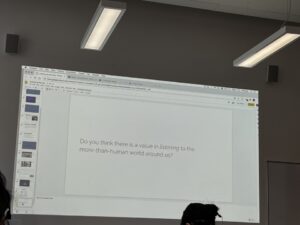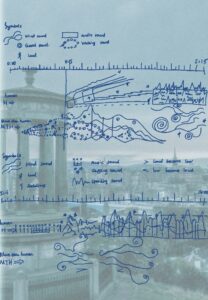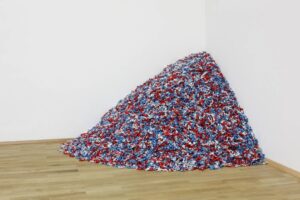1. During the first day’s introduction, I got a general idea of what Sprint 3 was going to focus on. I was impressed by this quote from Neimanis, which Frances shared with us in class: “Embodied knowledge, while often denigrated and disavowed within the modern colonial episteme confirms that Western scientistic validity comprises only one kind of knowing. I think so. But is it only through visuals that we can get information and share art? Later in the class we watched Jarman’s film work, which uses sensors other than sight and sound to build empathy with others about illness and queer relationships. After watching this video I thought it was mind-blowing, it was the first time I had ever felt and empathised fully with my sense of hearing. When my eyes could only see blue, I would find that the auditory sensory experience could be just as deep.
2. In Day 2 – Listening as Attuning Frances gave us a deep listening exercise, asking us to go to the sound of mobile phones, both inside and outside the building. After listening deeply to the sounds of our surroundings, I mainly thought about this question: Do you think there is a value in listening to the more-than-human world around us?

In my opinion, the answer to this question is yes, and it is very necessary. In our daily lives, we often use our sight to take in our surroundings and tend to ignore the experience of our other senses. After this deep listening exercise, I found that it is very easy to close my eyes and listen to nature and to think differently. This can take me out of the immersive human community. I tried to imagine what I would hear if I were a tree on Calton Hill, and would I still be bothered by the problems of the human world? In my opinion, the greatest value of this experience was to detach myself from the world I am in now, to calm down, to feel, to find myself, and it is not easy for a person to allow themselves to be themselves in opinion.
3. Before our Basho group visited Calton Hill, I watched a video by Williams Lisa and read Simon Sheikh’s Essay, which gave me some insight into the history of Calton Hill and the Calton Hill Observatory, for example, the trade and transport of Calton Hill and the importance of the sugar industry’s imports and exports to Scotland. One of the things that struck me after reading the essay was that the Chanse Observatory at Calton Hill, Edinburgh, has become a metaphorical gallery as an art institution. The site is rich in years of historical awareness, a historic area that has been closed off to the public for many years, and in this case as a gallery space for contemporary art, offers an opportunity to examine and observe that will also help shape its next evolution.
Our group chose to go to Calton Hill before 1pm on a Sunday to collect material. The sensory approach we chose was auditory, as we were very inspired by the deep listening exercises in class. Before going to Calton Hill, I envisioned ahead of time what sounds I would hear on this journey. I imagined I was a tree on Calton Hill, when it was still an ordinary hill, and I listened to the sound of birds chirping in the morning, the sound of raindrops falling on the grass, the sound of the wind hitting the leaves, the sound of snow falling and all the other sounds that come from nature. I don’t know why, but in my initial vision, I neglected people, an important element. Perhaps it seemed to me that I would be able to immerse myself more in the sounds of nature if I were to detach myself from human society. Later, after watching the Collective Observations video, I realised that I might hear the sound of clocks, the sound of people remembering and mourning, the sound of astronomers calculating, and other sounds that are important to people.
After we arrived at Calton Hill and started recording, I began to focus on whether the sounds I was collecting were what I thought they would be. Together we recorded the sound of human footsteps, people talking, clapping, videos playing in the observatory, people swiping their cards to buy souvenirs, the sound of heaters in the exhibition hall, the sound of taxis driving up the hill, the sound of standing on top of the hill listening to the sounds of the city in the distance, such as police sirens, and even the sound of people we interviewed about their views of Calton Hill. Most of them are created directly or indirectly by humans. It was not the same as the purely natural sounds that I had envisaged at the beginning. So we integrated and compared the sounds we had collected, thinking about the concept of the class, the relationship between colonisers and decolonisers, and how to reflect on decolonisation from a colonial perspective.
Throughout the Trip, our relationship with Calton Hill was that of man and nature, but also that of the coloniser and the colonised. After actually arriving at Calton Hill, I then put myself in the position of imagining what I could feel with my sense of hearing if I were a tree on Calton Hill. In this day and age, the place I grew up in has been ‘colonised’ with labels, important landmarks of the city of Edinburgh, monuments, observatories and so on. There are very few voices that I can hear that come from nature. So, in a sense, Calton Hill and all the natural life on it has been colonised aurally by humans. If Calton Hill wasn’t so full of historical stories and monuments, and was just an ordinary hill, would the sounds on the hill be the same as they are now? I think the answer is no. An ordinary mountain would not have had the same colonial features as Calton Hill, with its masonry steps, resting benches, famous buildings and other things that have been colonised by humans and are still being improved, which is perhaps why some of those that were colonised today are more developed. But a new question also arises: are we humans seriously developed for nature? I think this will again be a new process of reflection.
4. In preparation for the presentation, I edited a small part of the audio and designed a PowerPoint for our group and presented the Process section. One of the important parts for me was the sound score drawn by TianAi Zhang, who visualised our recorded sounds, which was very clear and intuitive. I redesigned her sound score by adding a background and changing the colours. It looks like the one below.


5.
Do artworks focused on senses other than sight negate the visual completely or do they still have a visual aesthetic? Can you give examples to support your answer?
I would argue that focusing on artwork other than the visual does not completely negate the visual, and still has a visual aesthetic.
Take, for example, González-Torres’ Untitled (A portrait of Ross in L.A.), which Frances asked us to analyse.
This work of art is very unusual in that the artist allows the exhibitor to take a candy at random, so that the viewer’s sense of taste can relate to the exhibit. Unlike other art exhibitions where the security guards say “please don’t touch the exhibit”. I understand that Felix has used different coloured sugar paper candies to decorate the exhibition. One of the more iconic ones is a set of red, blue and white candy paper, the same colours as the American flag, which some say is a reflection of the over-consumption of modern capitalist society through orgies. I think this kind of exhibition is about allowing people to interact with other senses without losing the visual aesthetics. For not only the stimulation of the colour of the sweets, but also the process of the sweets going from more to less, these are the visual effects of the exhibit that cannot be ignored.




s2339972
28th November 2022 — 7:09 pm
This is a great blog and it was interesting to see how the author was able to take the theories he had been exposed to in class into the field and explore colonialism through sound, especially when the author ended with the question “Are we humans serious about evolving for nature?” This is very explorable and a testament to the authors’ ability to implement critical thinking. Their mix of icons, backgrounds and sounds in the PowerPoint presentation was impressive.
s2298567
3rd December 2022 — 6:47 pm
Borrui’s blog does a good job of explaining her understanding of beyond the visual, with a lot of analytical content. It also mentions untitled as a work of art to explain why sensory works of art other than visual do not completely negate visual effects and gives a good explanation.
s2248556
5th December 2022 — 3:58 pm
From the author’s article, it is not difficult to see that there is a very serious research. I think the part of sound visualization is very interesting. The article also explains the visual beauty through multiple examples.
s2313334
6th December 2022 — 10:31 pm
The post by borui zhang showed her unique understanding and interpretation of Beyond the visual, showed her division of labor and perfect cooperation in the group, and inspired me a lot and reflected on the visual presentation of our group, because Our two groups use similar means, so I am very touched.